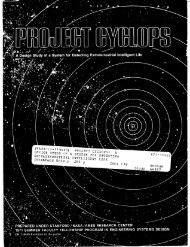Phase transition Clapeyron slopes and transition zone seismic ...
Phase transition Clapeyron slopes and transition zone seismic ...
Phase transition Clapeyron slopes and transition zone seismic ...
You also want an ePaper? Increase the reach of your titles
YUMPU automatically turns print PDFs into web optimized ePapers that Google loves.
15,858 BINA AND HELFFRICH: CLAPEYRON SLOPES<br />
Discussion <strong>and</strong> Conclusions<br />
Thus we find that the best fit <strong>Clapeyron</strong> slope of the<br />
410-km phase change does indeed exceed in magnitude<br />
that of the 660-km phase change for the Mg-bearing<br />
end-members of the Mg-Fe solid solutions. Furthermore,<br />
the effect of Fe in solid solution should yield even<br />
greater topography on t,he o ip <strong>transition</strong> but lessen<br />
that on the yipu + rnw <strong>transition</strong>.<br />
In view of this analysis, seismological observation of<br />
greater deflection of the 660-km discontinuity relative<br />
to the 410 is unexpected <strong>and</strong> surprising. One explanation<br />
might be that lateral temperature variations are<br />
greater near 660 km depth than they are near 410, a<br />
somewhat startling conclusion in view of <strong>seismic</strong> studies<br />
which suggest decreasing lateral heterogeneity in upper<br />
mantle velocities with increasing - depth - [Gr<strong>and</strong>, 1987;<br />
LeFevre <strong>and</strong> Helmberger, 1989; woodw&d <strong>and</strong> Masters,<br />
19911. However, such an explanation for greater<br />
topographic variation of the 660 might be consistent<br />
with a scenario in which the 660 constitutes a chemical<br />
<strong>and</strong> thermal boundary layer [Jeanloz <strong>and</strong> Thompson,<br />
19831. Another explanation for greater 660 variability<br />
near subducted slabs [Vidale <strong>and</strong> Benz, 19921 might be<br />
that the a+@ <strong>transition</strong> is kinetically hindered in their<br />
cold interiors, resulting in metastable persistence of a-<br />
olivine <strong>and</strong> a consequent decrease in the predicted uplift<br />
of the 410-km discontinuity in such regions [Sung<br />
<strong>and</strong> Bums, 19761. The existence of such wedges of<br />
metastable olivine, however, is currently a matter of active<br />
debate [Solomon <strong>and</strong> U, 1975; Roeeker, 1985; Iidaka<br />
<strong>and</strong> Suetsugu, 19921.<br />
An alternative interpretation, which is valid even in<br />
the absence oC therrnal boundary layers or metastable<br />
olivine wedges, is simply t,hat t,he topographic variations<br />
are in fact larger on the 410 than the 660 but that<br />
they are less visible <strong>seismic</strong>ally <strong>and</strong> so lead to underestimated<br />
topographic variability. Indeed, several studies<br />
[Davis et al., 1989; Paulssen, 1988a,b; Nakanishi, 1986,<br />
1988; Peiersen ei al., 19931 have noted the greater difficulty<br />
in observing boundary-interaction phases from<br />
the 410 relative to the 660. Large topographic variations<br />
would present a rougher surface to interacting<br />
<strong>seismic</strong> waves so that spatial averaging, scattering, <strong>and</strong><br />
focusing effects might conspire to conceal discont,inility<br />
topography [Richards, 1972; Davis et al., 19891. Even<br />
more fundamental, however, is the observation [Bina<br />
<strong>and</strong> Wood, 1987; Katsura <strong>and</strong> Iio, 19891 that the a+@<br />
<strong>transition</strong> becomes sharper at higher temperatures or,<br />
conversely, broader at lower temperatures. This lowtemperature<br />
broadening of the <strong>transition</strong>, which can be<br />
seen (Figure 4) by calculating stable phase assemblages<br />
along adiabats via numerical minimization of the free<br />
energy [cf. Bina <strong>and</strong> Wood, 19871, should make much<br />
410 topography less visible tosuch <strong>seismic</strong> probing. The<br />
660-km <strong>transition</strong>, on the other h<strong>and</strong>, appears to remain<br />
sharp over a broad range of temperatures [Ito <strong>and</strong><br />
Takahashi, 1989; Wood, 19901. Thus hot mantle should<br />
yield a sharp, depressed 410 <strong>and</strong> a sharp, uplifted 660;<br />
cold mantle should yield a diffuse, uplifted 410 <strong>and</strong> a<br />
sharp depressed 660.<br />
I3guse 4. Equilibrium phase proportions of a-olivine<br />
in a model mantle of (Mgo.9Feo.l)zSi04 composition<br />
illustrating low-temperature broadening of the a i P<br />
<strong>transition</strong>, calculated via free energy minimization using<br />
the thermodynamic parameters of Fez el al. [1991].<br />
'lkansition thicknesses are for a cool <strong>transition</strong> <strong>zone</strong> region<br />
(left, 950°C adiabat), a normal <strong>transition</strong> <strong>zone</strong><br />
region (middle, 1350°C adiabat), <strong>and</strong> a hot <strong>transition</strong><br />
<strong>zone</strong> region (right, 1750°C adiabat). Mole fraction of a<br />
phase is contoured for values of 0.2, 0.4, 0.6, <strong>and</strong> 0.8.<br />
Recent observations [Benz <strong>and</strong> Vidale, 19931 of sei*<br />
mic Pf410P' phases from a region beneath the Indian<br />
Ocean provide some support for this idea in that they<br />
require a very sharp (4 km wide) 410-km <strong>transition</strong> to<br />
accompany a sharp 660-km <strong>transition</strong> which is somewhat<br />
elevated (to 6.50 km). Contrary to the assertion<br />
of Benz <strong>and</strong> Vidale [1993], t,he high-pressure synthesis<br />
experiments [Katsura <strong>and</strong> Ito, 19891 place only an upper<br />
ho~ind on phase <strong>transition</strong> thickness, not a lower<br />
bound, due to the necessity of finite reaction overstep<br />
[Fyfe, 1960]. Moreover, the <strong>transition</strong> width is influenced<br />
by the solid solution properties of the participating<br />
phases, which are difficult to constrain experimen-<br />
tally [Wood, 19901. These details may contribi~te to up<br />
to 1/3 of the overall <strong>transition</strong> thickness predicted thermodynamically<br />
[Rina <strong>and</strong> Wood, 19871. Thus it is unrealistic<br />
to exclude a phase <strong>transition</strong> explanation for<br />
this discontinuity on the grounds that it overpredicts<br />
the width of the observed <strong>transition</strong>. The observation<br />
of Benz <strong>and</strong> Vadale's [I9931 P1410P' precursor phases is<br />
consistent with sharpening of the or-+@ <strong>transition</strong> in a<br />
region of high temperatures. The corresponding broadening<br />
of the <strong>transition</strong> which should attend regions of<br />
low t.emperati~re (Figure 4) may render the 410 so diffuse<br />
as to preclude the observation of topography via<br />
<strong>seismic</strong> boundary-interaction phases.<br />
Finally, the best fit <strong>Clapeyron</strong> <strong>slopes</strong> found herein differ<br />
from those in common use for convection modeling<br />
[Peltier <strong>and</strong> Solheim, 1992; Zhao el al., 1992; Honda<br />
et al., 1993; Tackley et al., 1993; Weinstein, 19931.<br />
In particular, the shallow slope found for the 660-km<br />
phase transformation may present a weaker barrier to













